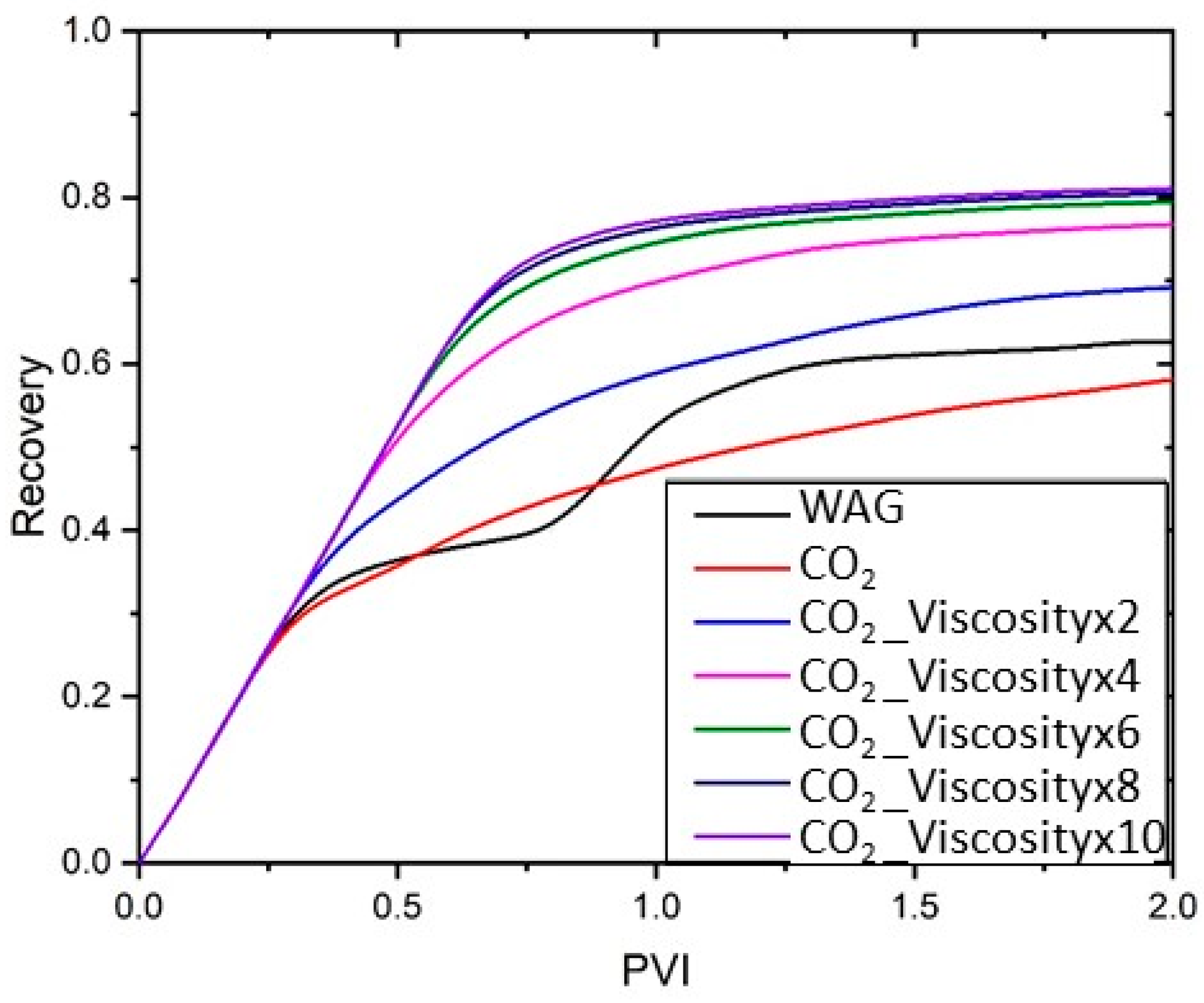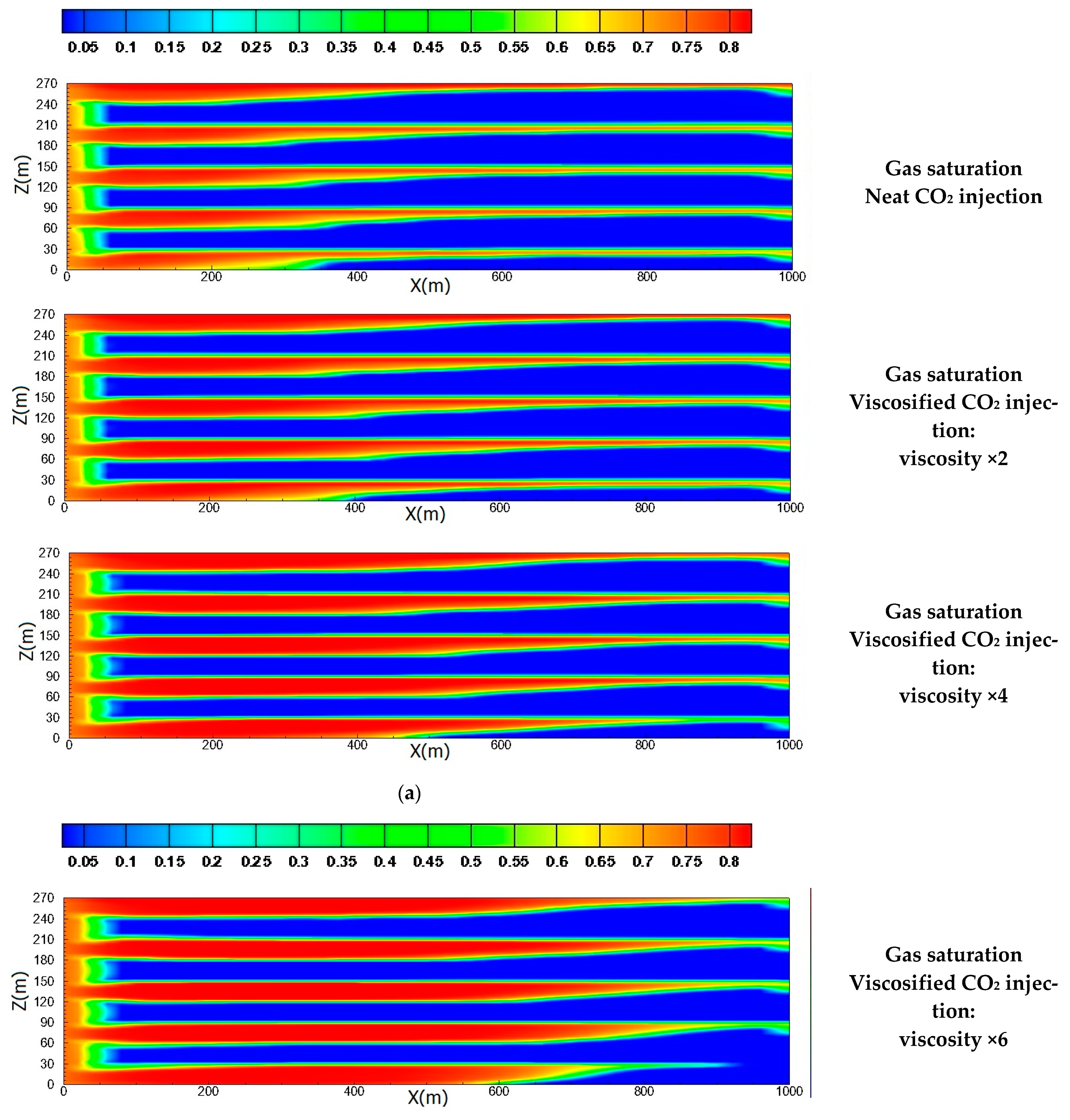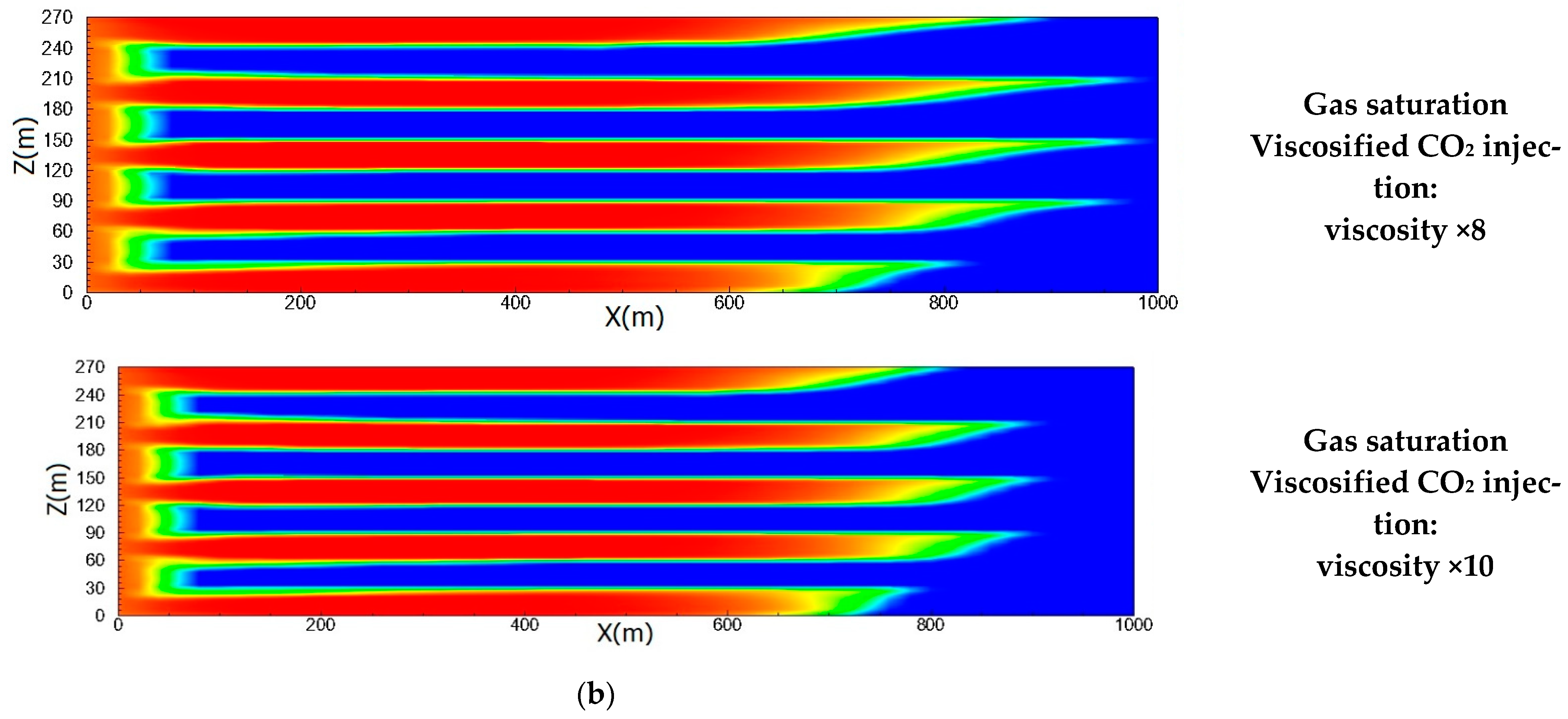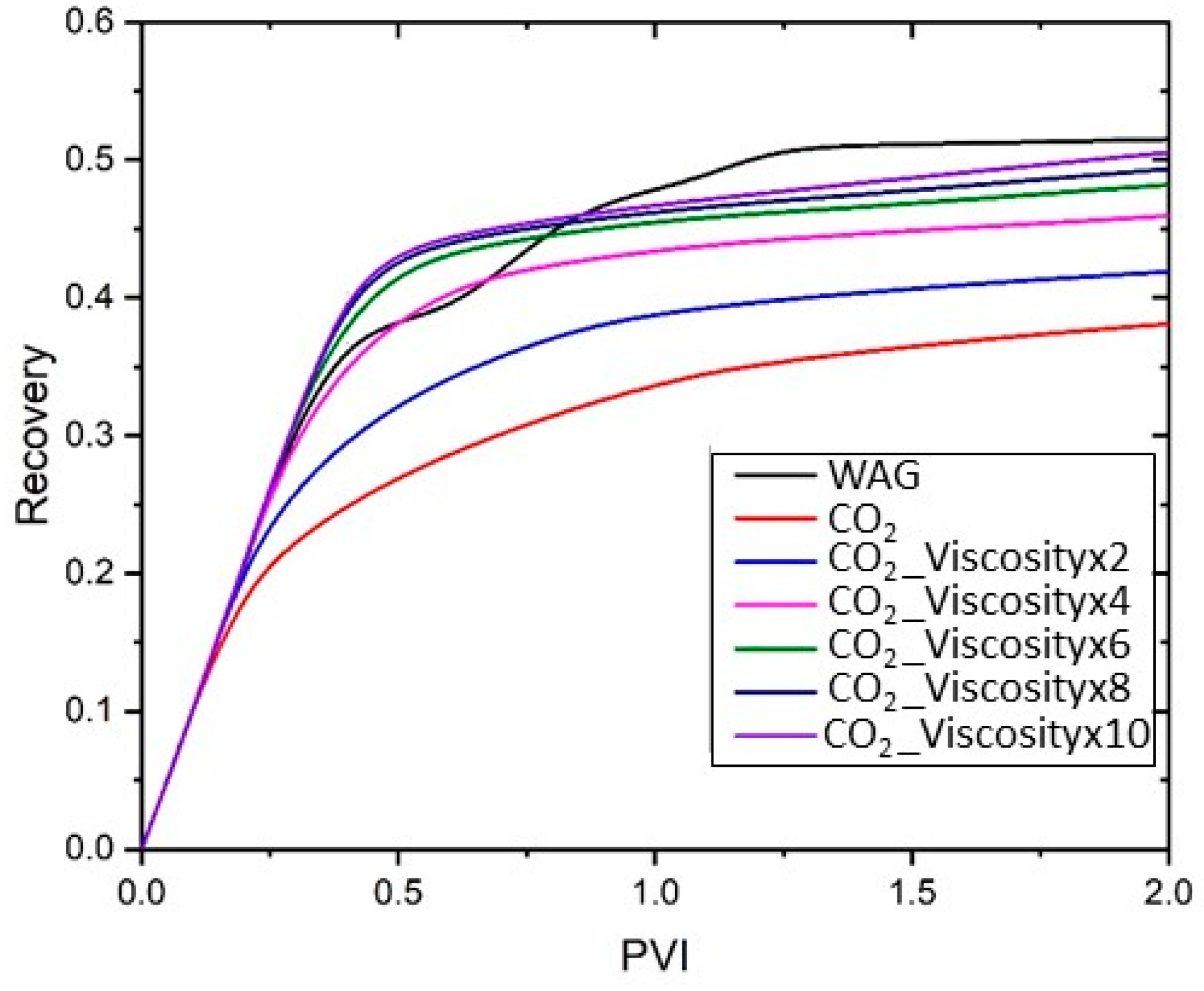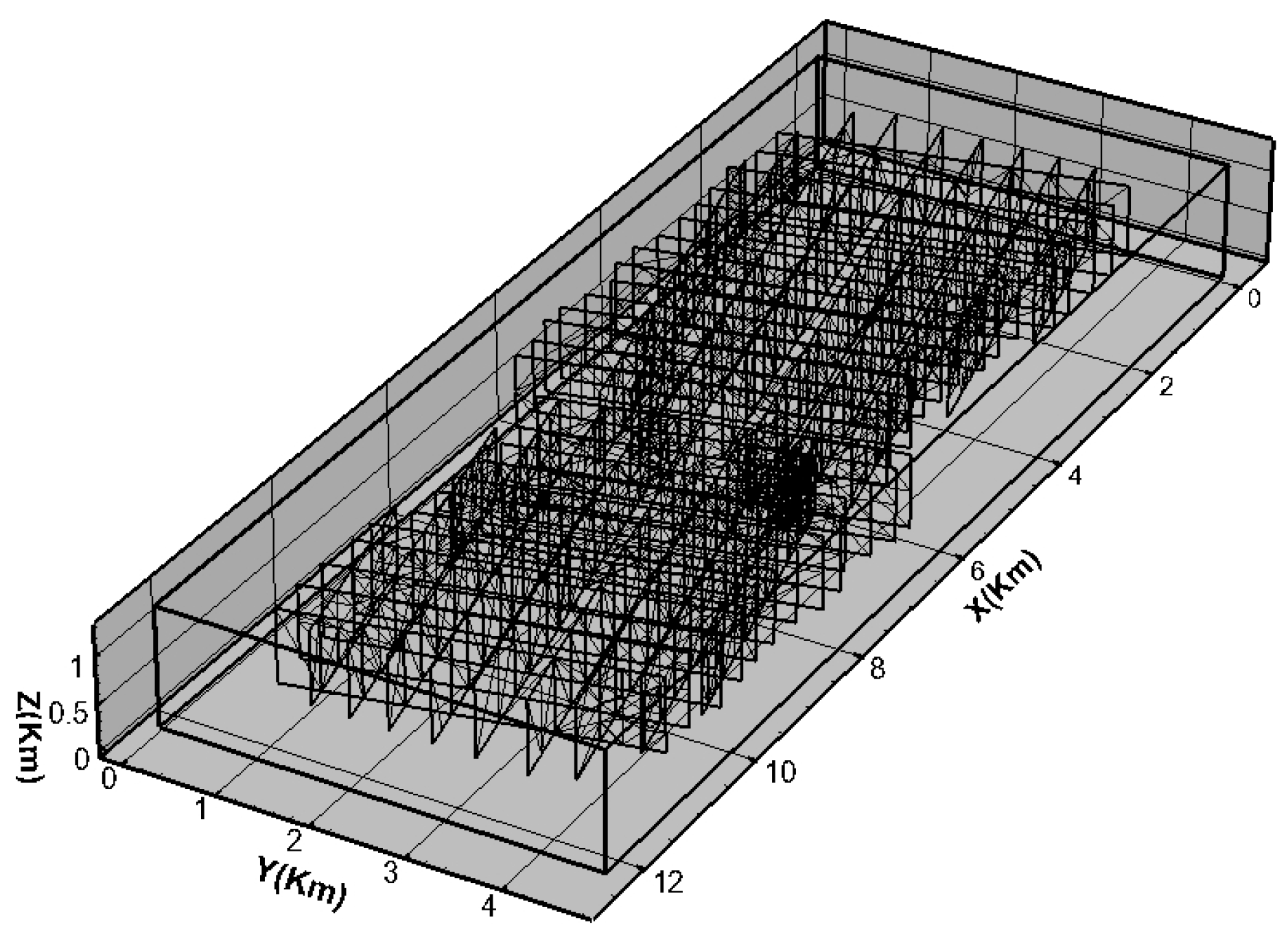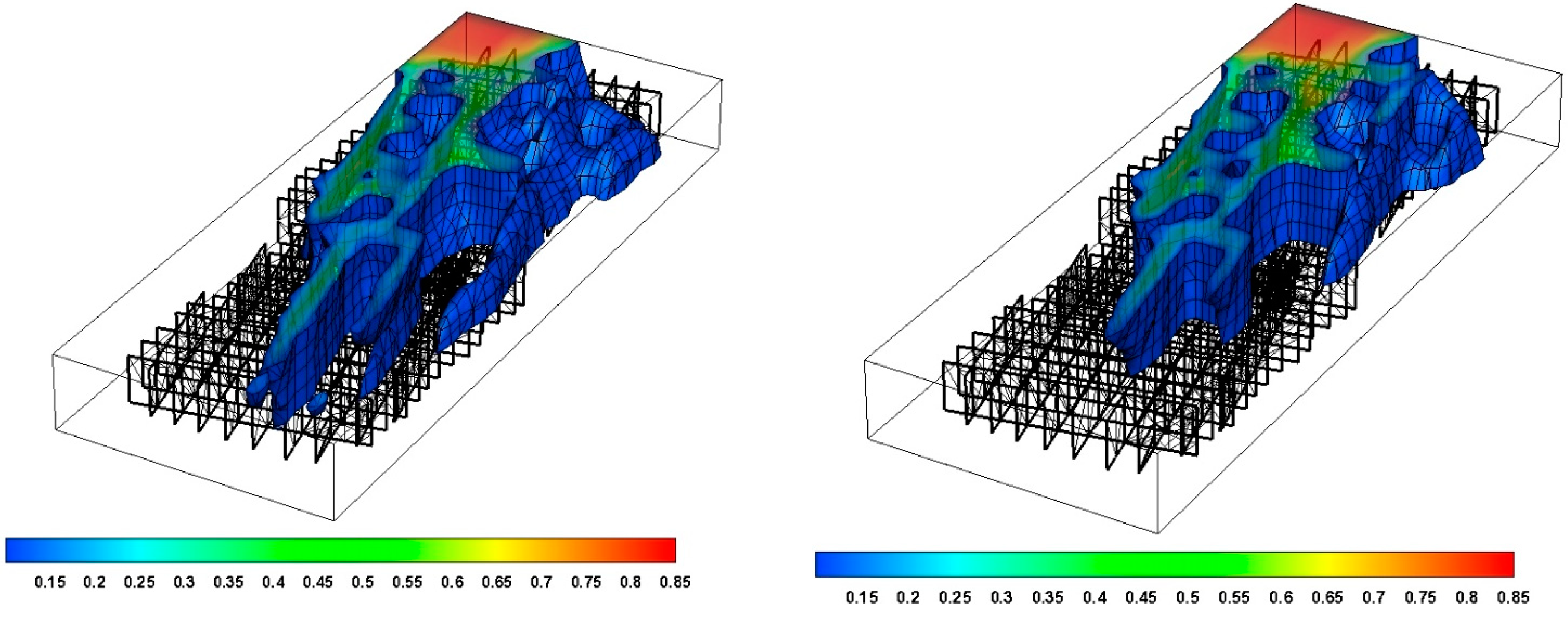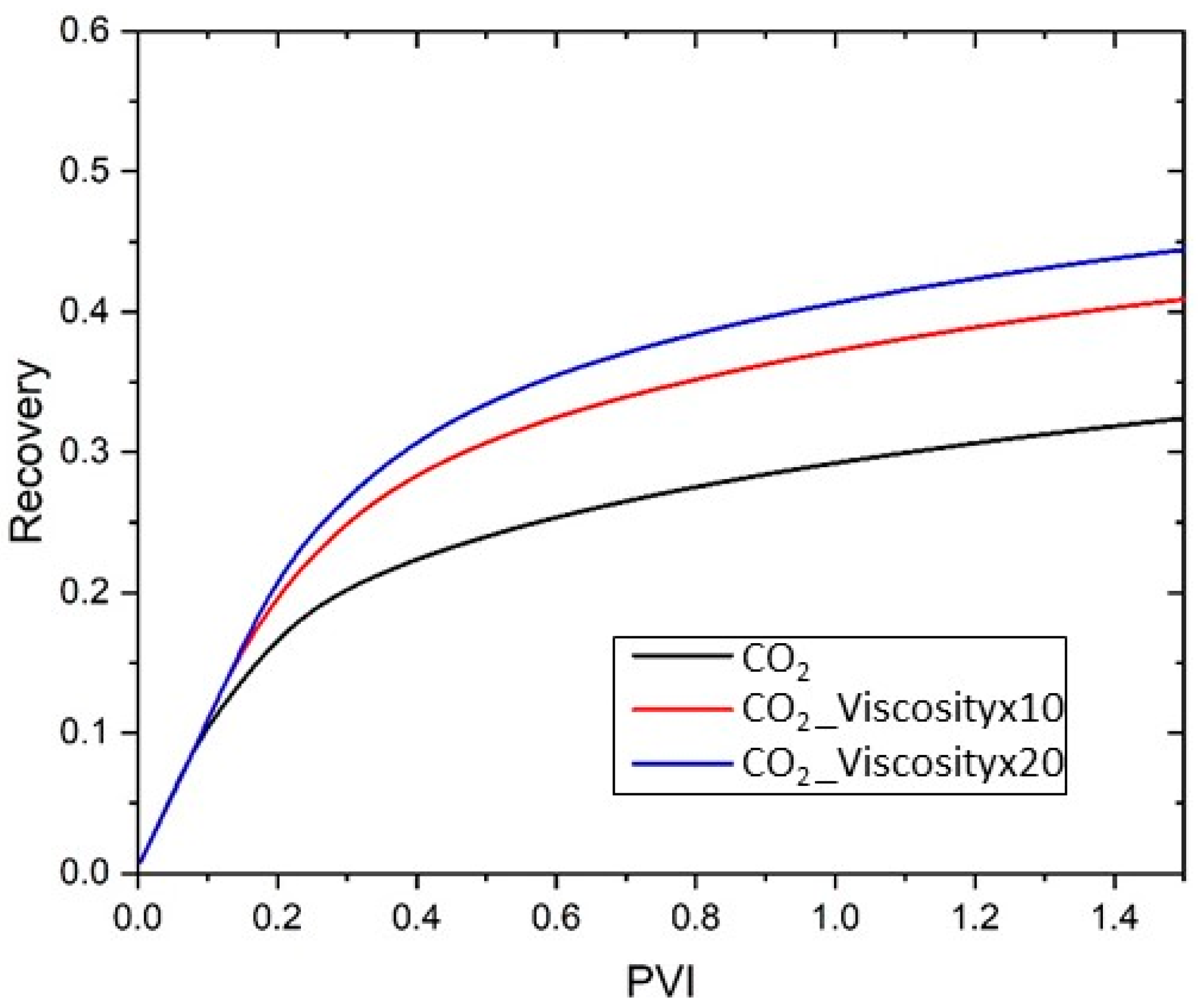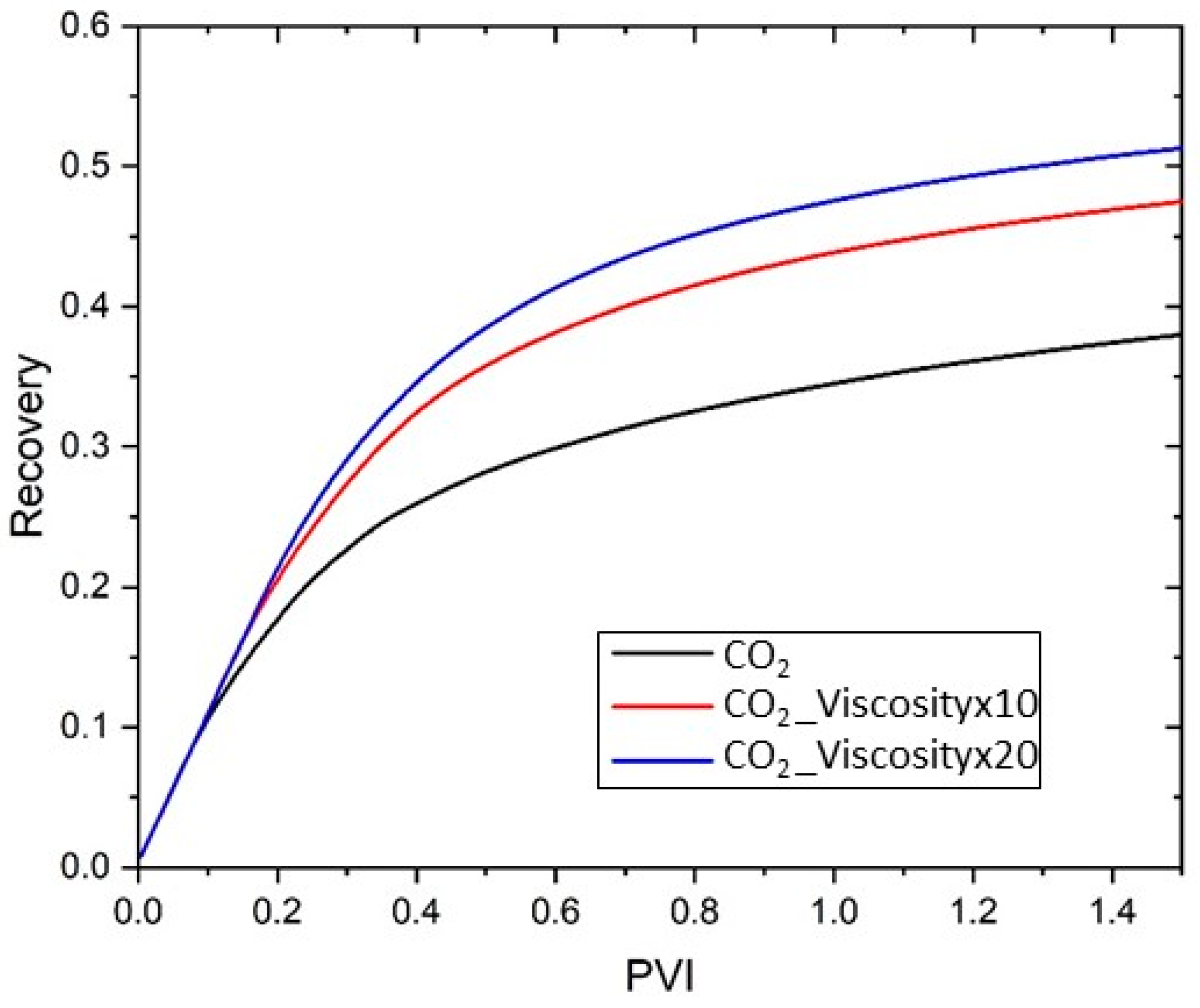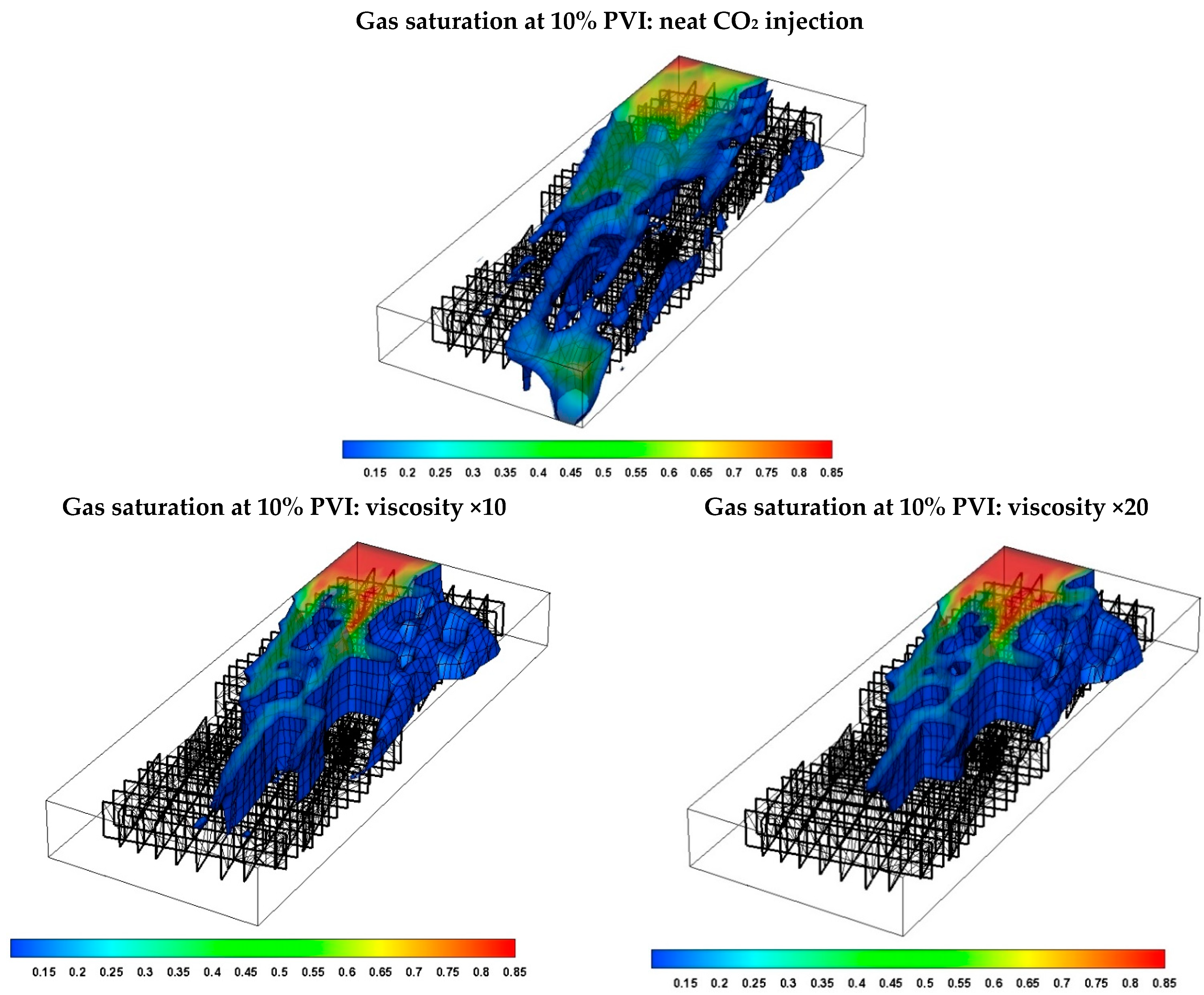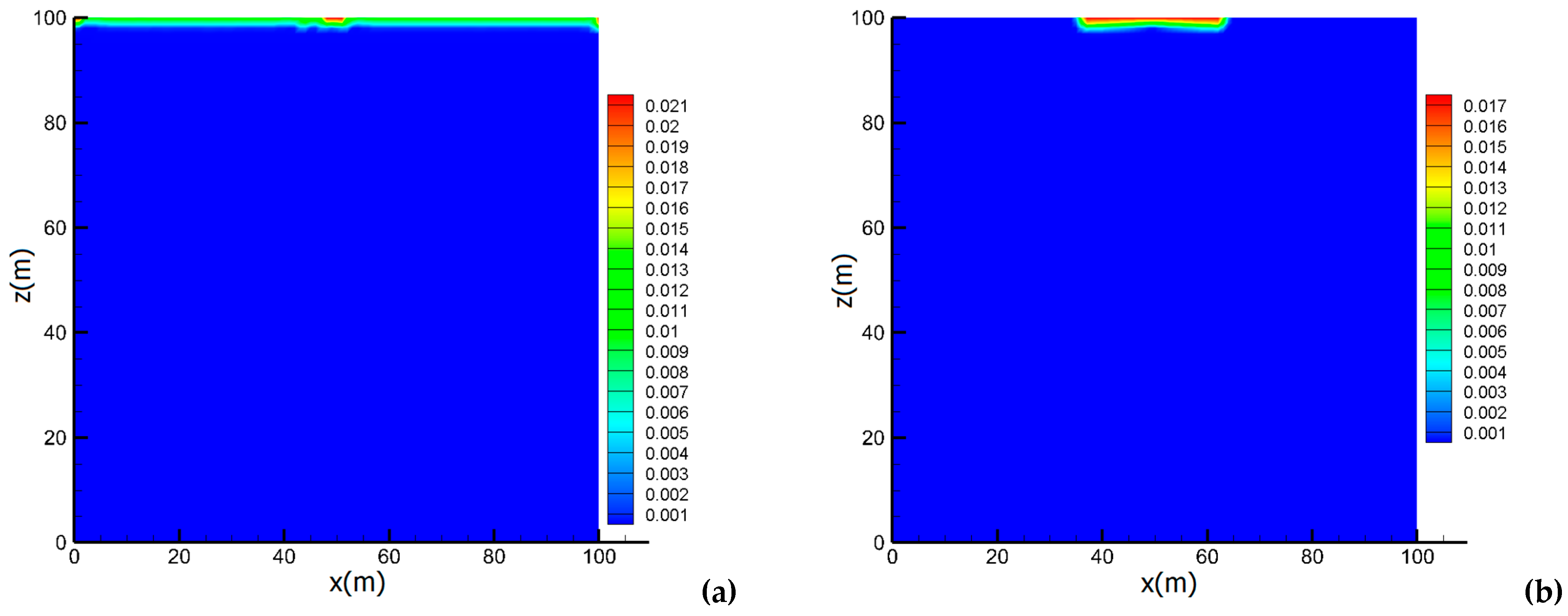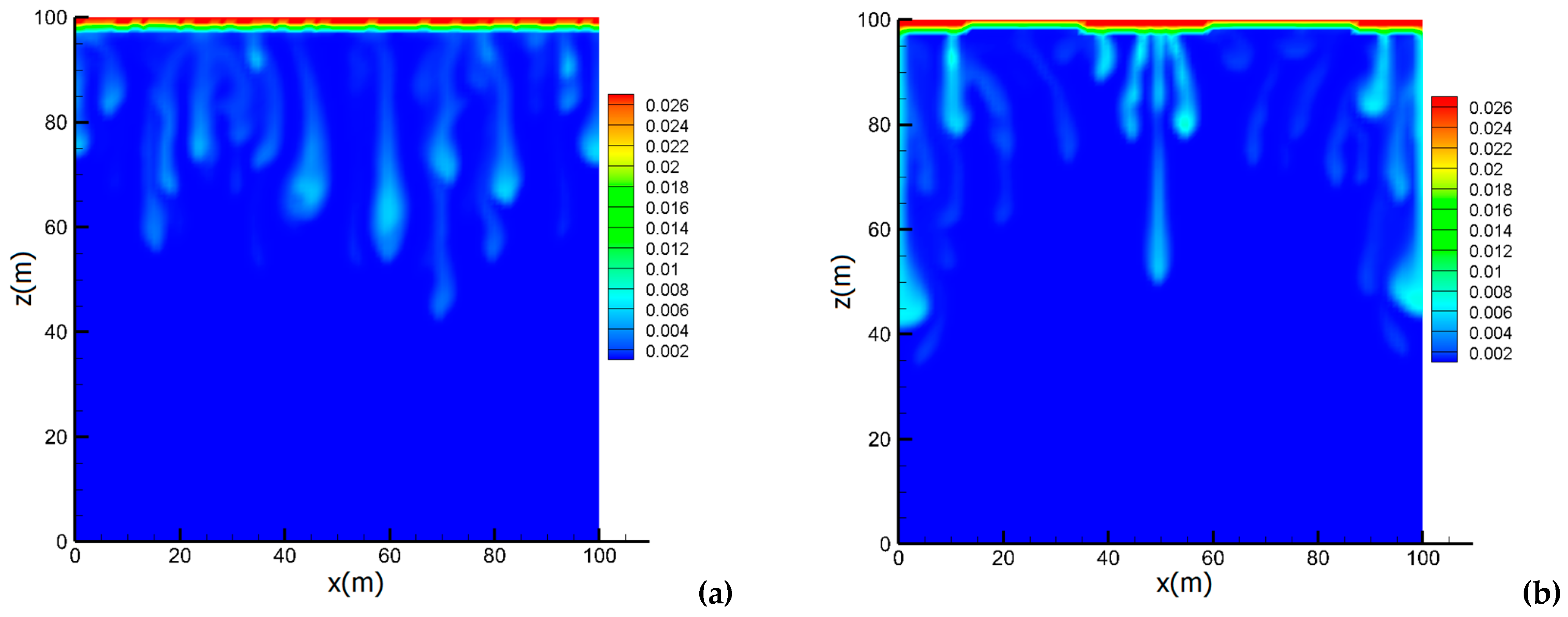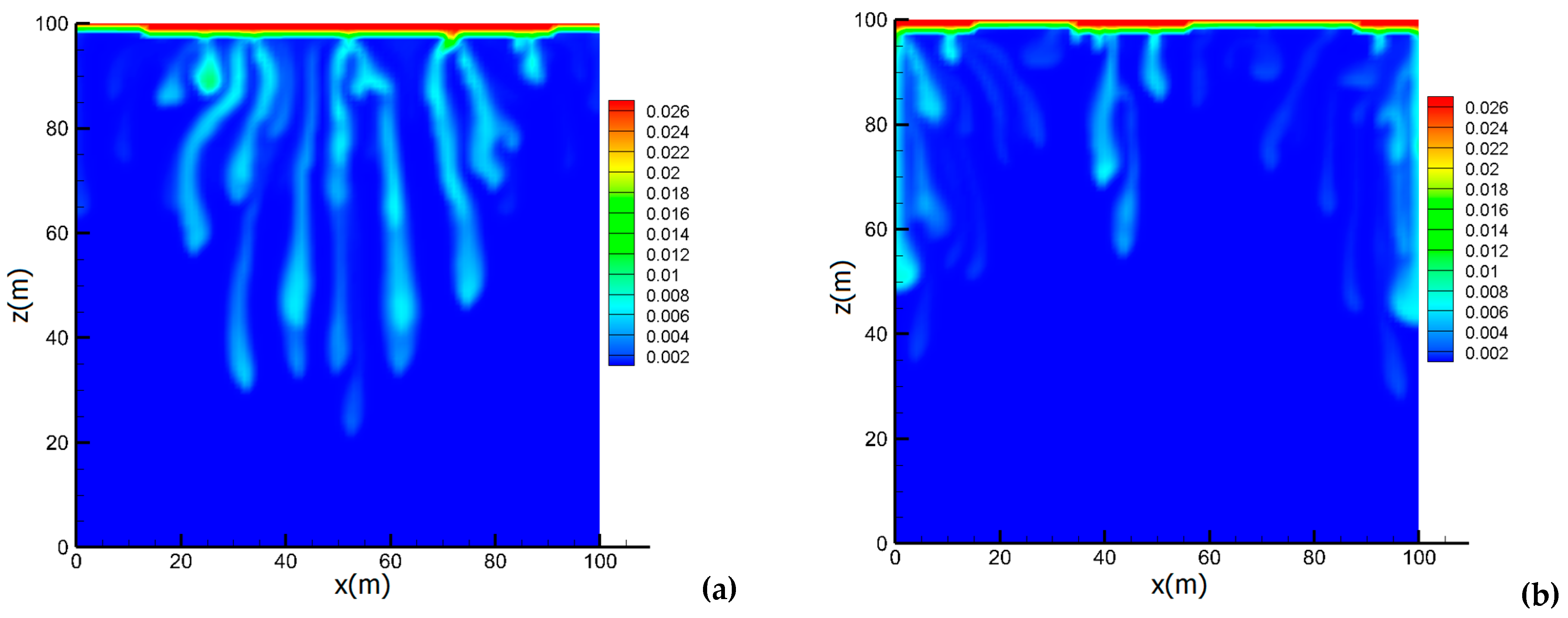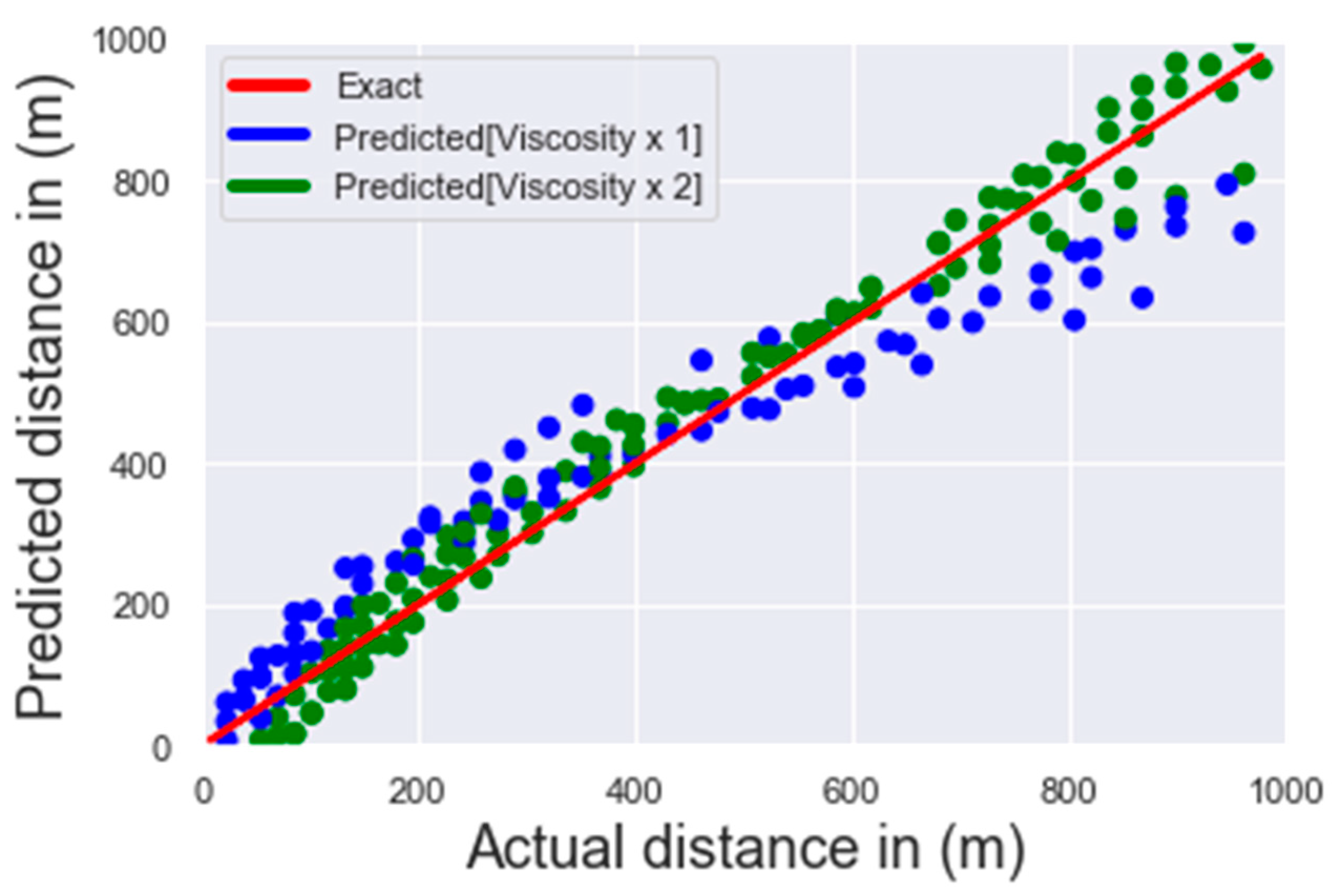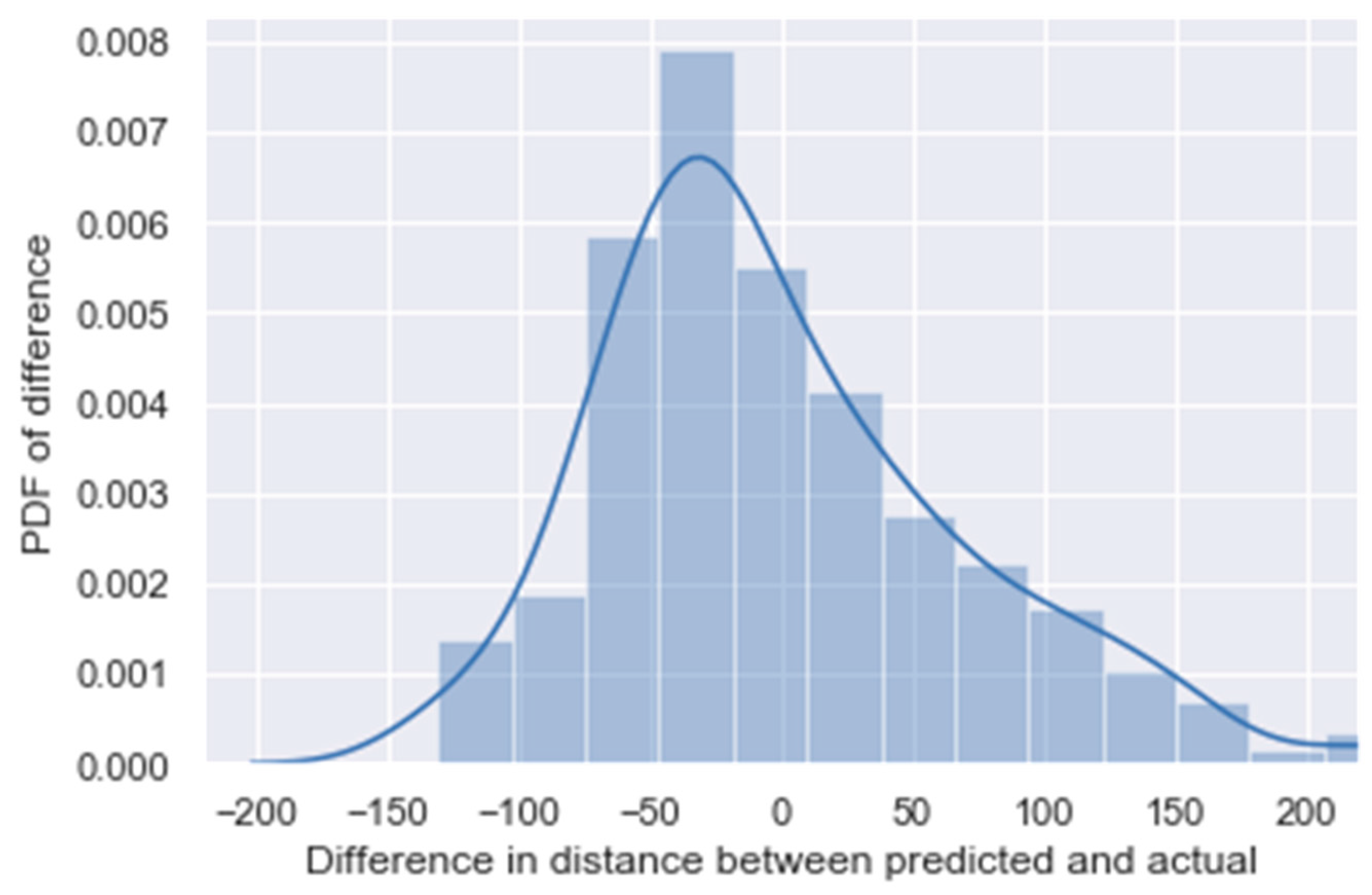1. Introduction
CO
2 emission to the atmosphere from fixed sources of production such as power, cement, aluminum, and steel plants and from oil and gas production constitutes more than one third of total emissions. Permanent storage of such a large amount of CO
2 in the subsurface may contribute greatly to the mitigation of global warming. A large amount of emitted CO
2 can be stored in subsurface brine aquifers. Large amounts of CO
2 can also be used in improved oil recovery, if it can be viscosified. The viscosification of CO
2 can be achieved using a low concentration of functional polymers. Lemaire et al. [
1] showed that CO
2-soluble polymers with low molecular weights and oligomers could be considered as modest thickeners.
CO2 has many desirable characteristics in improved oil recovery, both in secondary and tertiary modes. It swells the oil that it encounters, sometimes by as much as 80%. Swelling may be pronounced in both light oils and heavy oils. The method often has low residual oil saturation, which implies high microscopic displacement efficiency. It reduces the oil viscosity via dissolution, sometimes by an order of magnitude or more in heavier oils. The main drawback in the widespread use of CO2 for IOR is very low viscosity, which results in low sweep efficiency and early breakthrough. CO2 is a unique substance. At subsurface conditions it is often a supercritical fluid which has gas-like viscosity and liquid-like density.
Mobility modification of injected fluids often enhances recovery in oil and gas production [
2,
3,
4]. A viscosity reducer could be added to ease the displacement of the oil as shown in [
2], whereas a viscosity thickener might be needed in cases of high mobility of the injected fluid. Water alternating gas (WAG) injection is one of the techniques used to improve sweep efficiency and increase oil recovery. Residual oil saturation from CO
2 displacement is usually less than that from water displacement. Alternating injections of water and CO
2 at different cycles are of interest in WAG injection because this process improves sweep efficiency with intermittent injections of water and CO
2 [
5]. CO
2 swells the oil and reduces the oil’s residual saturation more than other gases. In addition to the economic advantages of using CO
2 in WAG processes, it also has environmental benefits related to global warming because it reduces the amount of greenhouse gas emissions to the atmosphere.
CO
2 foam is another mobility control alternative [
6,
7]. A drawback of CO
2 injection is low sweep efficiency due to gravity override and/or viscous fingering induced by its high mobility with respect to the oil in place. To overcome this limitation, Bond and Holbrook [
8] and Fried [
9] have proposed the foam process in order to improve sweep efficiency for gas displacement processes. Despite the reduction in CO
2 mobility, different studies have shown that oil recovery is sometimes impaired [
10] in CO
2 foam. Khulman [
11] has shown that oil may destabilize foam by spreading at bubble/film interfaces. Other studies [
12,
13] have shown that partitioning of a surfactant into oil affects foam stability. There may be significant adsorption of the foam-forming surfactant on the rock. In addition, high-permeability channels could be plugged by the foam [
14].
CO
2 viscosification is a viable alternative that takes advantage of CO
2 injection benefits and avoids the complexities of the foam process. CO
2 polymer thickeners have been proposed and recognized as a ‘game-changing technology’ [
15] in oil recovery. A CO
2 thickener increases the viscosity, which leads to a mobility reduction of the injected CO
2. The main characteristics of an effective CO
2 thickener are low or negligible adsorption to rock, low partitioning in the oil phase and the aqueous phase, and reversibility in flow rate increases and decreases [
16]. There are three different alternatives for CO
2 thickening: polymers and cosolvents, nanoparticles with and without polymers, and polymers alone. Bae and Irani [
17] presented a CO
2 polymer thickener that increases CO
2 viscosity up to 90-fold with a cosolvent. At 6 wt% polymer concentration, the increase in viscosity is 3.5 cp, and a 2 wt% polymer increases it to 0.8 cp in reservoir conditions [
17]. Despite the improved oil recovery in the core flow, the concentration of toluene cosolvent (up to 20 wt% toluene with 4 wt% polymer) makes the cost of field scale prohibitive. Nanoparticles have also been suggested for the vicosification of CO
2. Often the concentration is around 5 to 6 wt% for a five- to six-fold viscosity increase of CO
2 [
16]. Use of a polymer additive such as a fluorinated compound may increase CO
2 viscosity by 4- to 20-fold in 1 wt% and higher concentrations [
18,
19,
20]. However, the cost and environmental concern associated with fluorinated compounds are major limitations. CO
2 viscosification with direct thickeners in CO
2 emulsions in oil has been reviewed and validated experimentally in [
1].The guidelines of engineering a new CO
2 viscosifier were established in [
21]. The work presented in this paper is based on our recent findings on CO
2 viscosification and the engineering of new effective molecules. A five-fold viscosity enhancement has been shown to increase oil recovery in [
16], but the breakthrough time remains the same with neat CO
2.
The presented study is concerned with the investigation of the extent of viscosification of CO
2 in field scale using numerical modeling and simulation tools. The study covers different domains with different levels of complexity varying from a homogeneous 2D domain to a fractured 3D domain. Different papers have studied the effect of CO
2-enhanced viscosity as in [
16], however the work in [
16] is based on a finite-difference scheme and is limited to unfractured media. The work presented in this paper overcomes the limitations of the finite-difference method by using higher-order discretization in the modeling approach. The higher-order method provides a better description of physics with higher accuracy, in addition to ease of implementation in complex reservoirs. Numerical simulation results in this work show that CO
2-enhanced viscosity may significantly increase pressure mitigation and solubility trapping in CO
2 sequestration. The effect of different levels of viscosification is discussed in further detail in the following sections.
The paper is organized as follows: a general description of the model and the differential equations describing flow in unfractured and fractured porous media is presented in the first section; then, four numerical examples and a sensitivity study are discussed to demonstrate the effect of CO2-enhanced viscosity in different porous media; concluding remarks are presented in the last section.
3. Governing Equations
For the sake of completeness, the main equations that govern the compositional two-and three-phase flow are presented.
The mass transport equations for component
i in
nc-component mixture in the three-phase are given by:
and
where
denotes the porosity,
the velocity of phase
,
c the overall molar density of the mixture, and
and
are the overall mole fraction and the sink/source term of component
i in the mixture, respectively.
is the molar density of phase
,
is the mole fraction of component
i in phase
and
is the diffusive flux of component
i in phase
[
25].
is the computational domain,
denotes the simulation time, and
nc is the number of components.
The velocity of phase
is given by Darcy’s law:
where
K is the absolute permeability;
,
, and
are the relative permeability, dynamic viscosity, and mass density of phase
, respectively, with
;
is the pressure of phase
; and
g is the gravitational acceleration. The LBC method [
31] was used to describe the phase viscosities. Relative permeabilities were evaluated based on Stone’s model [
32,
33].
The total volume balance in the pressure equation is given by [
34,
35]:
where
is the total compressibility and
is the total partial molar volume of component
i.
The calculation of phase equilibrium was based on an initial guess from the stability analysis and the minimum of the Gibbs free energy. Equality of the fugacities of each component in the two hydrocarbon phases (oil and gas) implies:
The indices i and j in the above equation start at two since the first component is considered to be the aqueous phase that is not allowed to dissolve in the hydrocarbon phases and vice versa. However, CO2 dissolution is allowed in the aqueous phase. Note that Equation (5) assumes the same pressure in the gas and the oil phase and the curvature effect is assumed to be negligible in phase split calculations.
4. Examples
Four numerical examples are presented with different domain properties to study the effects of CO
2-enhanced viscosity and Fickian diffusion on oil recovery. The fourth numerical example is devoted to CO
2 sequestration in saline aquifers. Zero residual saturation of oil to CO
2 was considered and a 40% residual saturation of oil to water. Oil–water capillary pressure in the first two examples was calculated using Bensten and Anli’s model [
36]. Because the physics in every example is different, the number of elements varies between the examples. The mesh size in every example was chosen in a manner that guarantees numerical convergence. Further refinement in each mesh did not have a significant effect on the results.
4.1. Example 1: Homogeneous Medium
The first example is focused on the effect of CO
2 viscosity enhancement in a homogenous medium. A 1000 × 270 m
2 domain was discretized with 10,000 grids. Vertical injection and production wells were located at the left and right boundaries, respectively. Relevant data for the problem are given in
Table 1, and the oil composition is shown in
Table 2. The parameters for the use of the PR-EOS and CPA-EOS are provided in [
37].
The effect of varying viscosification degree on oil recovery was considered. In WAG injection, CO2 was injected for 0.5 PV followed by water for the same period; this was repeated for 2 cycles. In viscosified CO2 injection, the viscosity varied from 2- to 10-fold. The oil density in reservoir conditions was 0.74 g/cm3; the CO2 density in reservoir conditions was 0.92 g/cm3. Since CO2 density is higher than that of the oil, CO2 may segregate to the bottom.
Figure 1a,b shows the gas saturation from neat CO
2 injection and five viscosity enhancements (2-, 4-, 6-, 8-, and 10-fold viscosity enhancement with respect to the neat CO
2). All gas saturations in
Figure 1 are at 30% PVI. Saturation plots show that viscosity enhancement delayed gas breakthrough by reducing the gas mobility. Sweep efficiency was improved with viscosity enhancement.
Figure 2 shows the oil recovery. Two-fold viscosity enhancement increased the recovery by 20%. Increasing the viscosity by 10-fold led to a 40% improvement in recovery. It seems that a six-fold viscosity increase has a substantial effect on oil recovery improvement (the viscosity of the reservoir oil was 0.4 cp). A six-fold viscosification delayed breakthrough time by a factor of two compared to neat CO
2 injection. The WAG process in the homogenous media gave a recovery performance similar to that of neat CO
2 injection. In the next example, viscosified CO
2 injection is examined in a layered porous medium.
4.2. Example 2: Layered Media
This example considers a domain with nine alternating layers of 1 and 100 md starting with the high-permeability layer at the bottom. The domain size and relevant properties, including the oil composition and with the exception of permeability, were the same as in the previous example. Instead of injecting CO2 first, water was injected first in the WAG process.
Different viscosity enhancement cases were simulated and compared were compared to neat CO
2 injection (from 2- to 10-fold enhanced viscosity). The high-permeability layers were the main flow conduits for the injected fluid; as a result, the oil from the low permeability layers was not much recovered. The contour plots of the gas saturation in different viscosity enhancements are shown in
Figure 3a,b. Injected CO
2 mainly flowed through the high-permeability layers. As a result, the recovery in this example is lower than that in Example 1.
Figure 4 shows the recovery plots for different viscosity enhancements. The high mobility of CO
2 and the layering of the domain with high contrast in permeability led to low recovery in neat CO
2 injection. Increasing the viscosity of the CO
2 led to high recovery from the more permeable layers. In the process, vaporized methane and light oil components dissolved in the CO
2. As a result, the CO
2-rich phase became lighter than the oil and therefore flowed on the top of the more permeable layers in neat CO
2 injection or when the viscosification was low. There was a significant effect of viscosification on cumulative recovery, which reached 50% at a 10-fold viscosity enhancement. As stated above, the WAG injection in this example was started by first injecting water instead of CO
2. This was done to prevent early breakthrough from the high-permeability layers. The results showed substantial recovery from low-permeability layers due to capillary crossflow in WAG injection.
The effect was not significant due to the very thick layers that have been assumed in this example.
4.3. Example 3: Fractured Media
Underground gas storage in fractured reservoirs helps store large amounts of gas. An integrated model for gas storage in fractured reservoirs is presented in [
38]. This example expands into 3D fractured media. The same domain and oil properties are also used in Example 3. Other differences relate to the fracture permeability of 50 darcy (aperture of 0.5 mm). The domain dimensions are shown in
Figure 5; the media was discretized with 60,000 grids. The size of the formation was very large.
Injection and production wells were located at two diagonally opposite corners. The injection rate was 1% PV/year.
CO
2 injection in fractured media may give an early breakthrough due to high-permeability fractures. This is demonstrated in the contour plot of gas saturation at 10% PVI in neat CO
2 injection without viscosity enhancement (
Figure 6). Fickian diffusion was not considered in the results in
Figure 6. Viscosification may improve CO
2 injection performance and there may be a significant delay in breakthrough.
Figure 7 depicts recovery performance. The breakthrough from neat CO
2 injection was around 10% PVI. At a 20-fold viscosity enhancement, the breakthrough time was doubled. There was also a significant increase in oil recovery performance from CO
2 viscosification. Further improvements to recovery required a viscosity enhancement greater than 20-fold.
The oil recovery results are shown in
Figure 8; a 10-fold viscosity enhancement with Fickian diffusion gave about 47% recovery, whereas the recovery was about 38% with neat CO
2 injection. A 20-fold increase in viscosity gave a recovery of more than 50%. The pronounced effect of Fickian diffusion is due to the large surface area of the rock matrix. In
Figure 9, the gas saturation is shown at 10% PVI in neat and viscosified CO
2 injection.
4.4. Example 4: CO2 Sequestration
Carbon capture and storage is widely accepted as an effective strategy to mitigate anthropogenic CO2 emissions. Containment of injected CO2 is a critical part of the storage process. The extent to which the injected CO2 can be immobilized by CO2 viscosification was examined. A 2D aquifer domain of 100 × 100 m2 was considered. The permeability was 1 darcy and porosity was 20%. The domain was discretized with 10,000 quadrangles. The residual saturation of water was 30%; the endpoints were one and the exponents were two for both water and CO2. The injection of CO2 at the middle of the top boundary of the domain over injection lengths of 1 m and 5 m was investigated. The injection of neat CO2 is compared to the five-fold viscosity enhancement. The injection rate was 0.15% PV/year. The initial pressure at the bottom was 100 bar, and the temperature was 350 K.
Figure 10 shows the CO
2 mole fraction at 0.6 years (neat and viscosified CO
2) for the 1 m injection length at the middle of the top boundary.
The pressure at the injection well at 0.6 years of injection increased to 105 bar from viscosified CO
2 and to 164 bar from neat CO
2 injection. At 2 years of injection the pressure at the injector location was 124 bar (viscosified) and 188 bar (neat) CO
2 injection. At 20 years the pressure was 303 bar (viscosified) and 377 bar (neat).
Figure 11 shows the CO
2 overall mole fraction at 20 years of injection.
To evaluate the effect of a large injection length, the simulation considered the effect of a 5 m injection length symmetrically located at the top middle boundary. A large injection length leads to lower pressure buildup. In the neat CO
2 injection, the pressure at the injector was 103 bar, and in the viscosified CO
2 injection, the pressure was 102 bar at 0.6 years of injection. In
Figure 12, the CO
2 overall mole fraction is shown at 20 years of injection with the 5 m injection length at the top.
Due to the greater injection length, the pressure buildup in the neat CO2 injection was 330 bar. In the viscosified CO2 injection, the pressure at the injector was 303 bar. The distribution of the overall mole fraction of CO2 in the water phase showed a higher concentration near the middle region in the neat CO2 injection. The results indicated that viscosification for the small injection length had a higher effect on the mitigation of pressure increase from CO2 sequestration in saline aquifers.
5. Statistical Analysis
A detailed statistical analysis is presented in this section. The aim is to quantify the effect of injection rate, permeability, and a two-fold viscosity enhancement on the position of the injected CO
2 front as a function of PVI. The more the front is retarded, the more the sweeping efficiency is improved. This study considered the average position of the CO
2 front to be a dependent variable of injection rate, permeability, and viscosity enhancement. In this study, a regression model was developed to predict the position of the CO
2 front based on a combination of 12 independent simulations. The 12 simulations were divided into two groups, each of which consisted of 6 independent simulations, the first group without viscosity enhancement and the second group with a doubling of the viscosity of the injected CO
2. Within each subgroup (six independent simulations) three different injection rates were considered: 0.05, 0.1, and 0.2 PV/year. With each injection rate a separate simulation was considered on a domain with permeability values of 10 and 50 md. During each of the independent simulations, the average position of the CO
2 front at a different PVI was recorded. A total of 1300 data points were obtained, of which 900 data points were used to develop the regression model. The independent variables have different dimensions; therefore, a standardization was applied with respect to their average value and the respective standard deviation.
Table 3 shows the regression coefficients for the three independent (standardized) variables: injection rate, permeability, and viscosity enhancement. As shown in
Table 3, the effect of viscosity enhancement on retarding the CO
2 front (and as a result on improving sweeping efficiency) was almost double the injection rate effect. The effect of the latter (injection rate) was around 18 times more important to front displacement compared to the effect of permeability. As expected, permeability had a positive regression weight. That is, the higher the permeability, the faster the front travels in the reservoir.
Figure 13 shows the predicted front position in the reservoir (in meters) as a function of the actual front position (the one obtained from the simulation). The same plot shows the exact solution (that is, if the model is 100% accurate). The results show that the model can give an accurate predicted front position compared to the exact front position obtained from the simulations; however, the model is more accurate in predicting the front in the enhanced viscosity compared to the unaltered viscosity. This is because without viscosity enhancement, CO
2 mobility is much higher, and therefore the front displacement is much faster. This makes the prediction error higher.
Figure 14 shows the probability distribution function (PDF) for the difference in the front position between the predicted and actual values. The PDF plot shows that the difference between the predicted and actual values was concentrated around zero, indicating the accuracy of the regression model.
6. Concluding Remarks
Viscosified CO2 oligomer hydrocarbons have recently advanced in effectiveness. A major element of effectiveness of new molecules is negligible adsorption. Another observed side effect of viscosification is a reduction in residual water saturation. In the simulations presented in this work, the change in residual saturation from viscosified CO2 has not been included. Nevertheless, a significant increase in the breakthrough time was observed.
This work centers around an investigation of the degree of viscosification that will increase oil recovery performance in unfractured and fractured media. In CO2 sequestration, the viscosity of reservoir brine, especially at high reservoir temperature conditions, may require an increase by a factor of five to six. The mobility can then be improved significantly. In oil formations, depending on layering and on the extent of the fractures, a viscosity increase of CO2 may be several times this or higher.
The critical element in subsurface storge and use of CO2 is mobility control. In oil recovery applications, the outcome is a delay in breakthrough time. In CO2 sequestration, the increase in dissolution trapping and the lowering of the pressure increase contribute to safer conditions.
Higher-order discretization schemes have been used in composition calculation and mixed finite element in flux calculation for high accuracy. In future work, more detailed simulations with more accurate relative permeability and capillary pressure functions can be used to cover the effects of formation heterogeneity, layering, and fractures.
The use of viscosified CO2 is expected to be the method of choice due to the simplicity of the process compared to alternatives, its effectiveness, and its compatibility with current trends in environmental stewardship.


